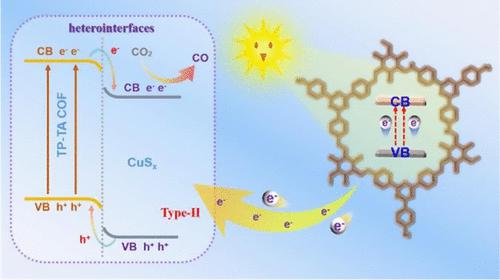当前位置:
X-MOL 学术
›
Inorg. Chem.
›
论文详情
Our official English website, www.x-mol.net, welcomes your feedback! (Note: you will need to create a separate account there.)
Defect Engineering in CuSx/COF Hybridized Heterostructures: Synergistic Facilitation of the Charge Migration for an Efficacious Photocatalytic Conversion of CO2 into CO
Inorganic Chemistry ( IF 4.6 ) Pub Date : 2022-11-30 , DOI: 10.1021/acs.inorgchem.2c03481 Jiaxin Mao 1 , Lei Wang 1 , Siyan Qu 1 , Yang Zhang 1 , Jingwei Huang 1 , Houde She 1 , Yan Bai 1 , Qizhao Wang 1, 2
Inorganic Chemistry ( IF 4.6 ) Pub Date : 2022-11-30 , DOI: 10.1021/acs.inorgchem.2c03481 Jiaxin Mao 1 , Lei Wang 1 , Siyan Qu 1 , Yang Zhang 1 , Jingwei Huang 1 , Houde She 1 , Yan Bai 1 , Qizhao Wang 1, 2
Affiliation

|
The photocatalytic CO2 reduction reaction (CO2RR) provides an attractive approach to tackling environmental issues. To actualize the optimal catalytic efficiency, one efficacious strategy is to rationally modulate the charge migration for the adopted heterogeneous catalysts. Herein, by virtue of a one-step hydrothermal method, Cu2S nanospheres and defect-rich Cu2S (CuSx) nanosheets are wrapped by a triazine-containing covalent framework (TP-TA COF), resulting in CuSx/TP-TA and Cu2S/TP-TA. Owing to the heterojunction construction that suppresses the carrier recombination, both hybridized structures present enhanced charge migration in comparison to that of their corresponding sulfides and COF constituents. It is worth emphasizing that CuSx/TP-TA proffers a significantly greater photocurrent than Cu2S/TP-TA. The subsequent photocatalytic reduction of CO2 also exhibits an apparently higher CO evolution rate, about 2.8 times higher than the Cu2S/TP-TA photocatalyst. The above evident improvement owes much to the heterostructure establishment between CuSx and TP-TA COF, as well as the synergistic effect provided by the defect engineering for CuSx, both of which are able to enhance the separation efficiency of photoinduced carriers. Our work sheds light on the rational construction of heterogeneous structures between organic and inorganic photocatalysts, which emphasizes the possible synergistic effect of defect centers for enhancing photocatalytic performance.
中文翻译:

CuSx/COF 杂化异质结构中的缺陷工程:协同促进电荷迁移,将 CO2 有效光催化转化为 CO
光催化CO 2还原反应(CO 2 RR) 为解决环境问题提供了一种有吸引力的方法。为了实现最佳催化效率,一种有效的策略是合理调节所采用的多相催化剂的电荷迁移。在此,凭借一步水热法,Cu 2 S纳米球和富含缺陷的Cu 2 S(CuS x)纳米片被含三嗪的共价骨架(TP-TA COF)包裹,产生CuS x /TP -TA和Cu 2S/TP-TA。由于抑制载流子复合的异质结结构,与相应的硫化物和 COF 成分相比,两种杂化结构都表现出增强的电荷迁移。值得强调的是,CuS x /TP-TA 提供比 Cu 2 S/TP-TA大得多的光电流。随后的 CO 2光催化还原也表现出明显更高的 CO 释放速率,比 Cu 2 S/TP-TA 光催化剂高约 2.8 倍。上述明显改善很大程度上归功于 CuS x和 TP-TA COF 之间异质结构的建立,以及缺陷工程为 CuS x提供的协同效应,两者都能够提高光生载流子的分离效率。我们的工作阐明了有机和无机光催化剂之间异质结构的合理构建,强调了缺陷中心可能对提高光催化性能的协同作用。
更新日期:2022-11-30
中文翻译:

CuSx/COF 杂化异质结构中的缺陷工程:协同促进电荷迁移,将 CO2 有效光催化转化为 CO
光催化CO 2还原反应(CO 2 RR) 为解决环境问题提供了一种有吸引力的方法。为了实现最佳催化效率,一种有效的策略是合理调节所采用的多相催化剂的电荷迁移。在此,凭借一步水热法,Cu 2 S纳米球和富含缺陷的Cu 2 S(CuS x)纳米片被含三嗪的共价骨架(TP-TA COF)包裹,产生CuS x /TP -TA和Cu 2S/TP-TA。由于抑制载流子复合的异质结结构,与相应的硫化物和 COF 成分相比,两种杂化结构都表现出增强的电荷迁移。值得强调的是,CuS x /TP-TA 提供比 Cu 2 S/TP-TA大得多的光电流。随后的 CO 2光催化还原也表现出明显更高的 CO 释放速率,比 Cu 2 S/TP-TA 光催化剂高约 2.8 倍。上述明显改善很大程度上归功于 CuS x和 TP-TA COF 之间异质结构的建立,以及缺陷工程为 CuS x提供的协同效应,两者都能够提高光生载流子的分离效率。我们的工作阐明了有机和无机光催化剂之间异质结构的合理构建,强调了缺陷中心可能对提高光催化性能的协同作用。


























 京公网安备 11010802027423号
京公网安备 11010802027423号